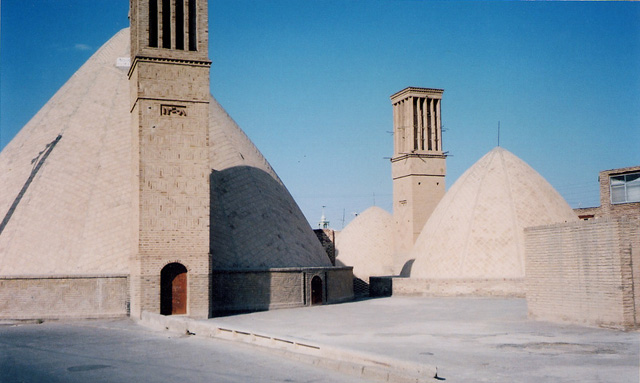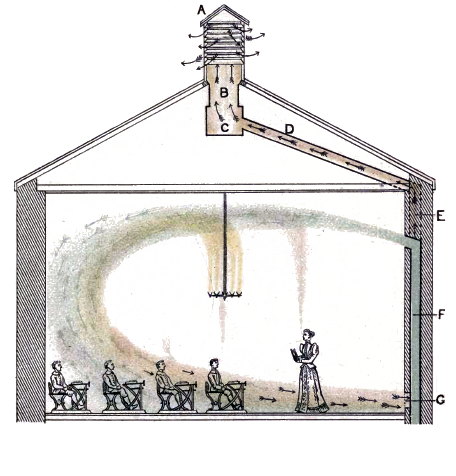|
Bell Mouth
In building services engineering and HVAC, a bell mouth is a tapered expanding or reducing opening in the end of a ventilation duct, so named because the taper can resemble that of a bell shape. They are primarily designed and used for return air or extract air purposes within building ventilation systems, more commonly located within ceiling voids or other similar plenum Plenum may refer to: * Plenum chamber, a chamber intended to contain air, gas, or liquid at positive pressure * Plenism, or ''Horror vacui'' (physics) the concept that "nature abhors a vacuum" * Plenum (meeting), a meeting of a deliberative assem .... The bellmouth cross-sectional area is normally double that of the duct area so that the air velocity entering the bellmouth is low (to reduce noise, turbulence and pressure drop), and gradually increases to the normal design velocity of the ductwork. The angle of the bellmouth is normally tapered at about 45° as a balance between keeping the bellmouth short with ... [...More Info...] [...Related Items...] OR: [Wikipedia] [Google] [Baidu] |
Building Services Engineering
Building services engineering is a professional engineering discipline that strives to achieve a safe and comfortable indoor environment whilst minimizing the environmental impact of a building. Alternative titles are "building services engineering (BSE)"; also known as "MEP" ( Mechanical, Electrical and Plumbing), an emerging branch of engineering"; "technical building services"; and "building engineering" or "facilities and services planning engineering". The term building services engineering is widely used in Commonwealth countries (incl. United Kingdom, Ireland, Canada and Australia), but in the United States of America, In Asian countries Saudi Arabia and Pakistan, the MEP engineers are known as "services planners". In some countries, a "building services engineer" is a Senior MEP engineer with experience in the installation of equipment in Buildings Construction, Building Maintenance, Management, integration of electrical, mechanical, fire, hydraulic, security and communic ... [...More Info...] [...Related Items...] OR: [Wikipedia] [Google] [Baidu] |
HVAC
Heating, ventilation, and air conditioning (HVAC) is the use of various technologies to control the temperature, humidity, and purity of the air in an enclosed space. Its goal is to provide thermal comfort and acceptable indoor air quality. HVAC system design is a subdiscipline of mechanical engineering, based on the principles of thermodynamics, fluid mechanics, and heat transfer. "Refrigeration" is sometimes added to the field's abbreviation as HVAC&R or HVACR, or "ventilation" is dropped, as in HACR (as in the designation of HACR-rated circuit breakers). HVAC is an important part of residential structures such as single family homes, apartment buildings, hotels, and senior living facilities; medium to large industrial and office buildings such as skyscrapers and hospitals; vehicles such as cars, trains, airplanes, ships and submarines; and in marine environments, where safe and Sick building syndrome, healthy building conditions are regulated with respect to temperature and ... [...More Info...] [...Related Items...] OR: [Wikipedia] [Google] [Baidu] |
Ventilation (architecture)
Ventilation is the intentional introduction of outdoor air into a space. Ventilation is mainly used to control indoor air quality by diluting and displacing indoor pollutants; it can also be used to control indoor temperature, humidity, and air motion to benefit thermal comfort, satisfaction with other aspects of indoor environment, or other objectives. The intentional introduction of outdoor air is usually categorized as either mechanical ventilation, natural ventilation, or mixed-mode ventilation (hybrid ventilation). * Mechanical ventilation is the intentional fan driven flow of outdoor air into a building. Mechanical ventilation systems may include supply fans (which push outdoor air into a building), exhaust fans (which draw air out of building and thereby cause equal ventilation flow into a building), or a combination of both. Mechanical ventilation is often provided by equipment that is also used to heat and cool a space. * Natural ventilation is the intentional passive fl ... [...More Info...] [...Related Items...] OR: [Wikipedia] [Google] [Baidu] |
Bell (instrument)
A bell is a directly struck idiophone percussion instrument. Most bells have the shape of a hollow cup that when struck vibrates in a single strong strike tone, with its sides forming an efficient resonator. The strike may be made by an internal "clapper" or "uvula", an external hammer, or—in small bells—by a small loose sphere enclosed within the body of the bell (jingle bell). Bells are usually cast from bell metal (a type of bronze) for its resonant properties, but can also be made from other hard materials. This depends on the function. Some small bells such as ornamental bells or cowbells can be made from cast or pressed metal, glass or ceramic, but large bells such as a church, clock and tower bells are normally cast from bell metal. Bells intended to be heard over a wide area can range from a single bell hung in a turret or bell-gable, to a musical ensemble such as an English ring of bells, a carillon or a Russian zvon which are tuned to a common scale and instal ... [...More Info...] [...Related Items...] OR: [Wikipedia] [Google] [Baidu] |
Plenum Chamber
A plenum chamber is a pressurised housing containing a fluid (typically air) at positive pressure. One of its functions is to equalise pressure for more even distribution, compensating for irregular supply or demand. It is typically relatively large in volume and thus has relatively low velocity compared to the system's other components. In wind tunnels, rockets, and many flow applications, it is a chamber upstream on the fluid flow where the fluid initially resides (approximately at rest). It can also work as an acoustic silencer. Examples of plenum chambers include those used with: * Superchargers * Hovercraft * Corliss steam engines * Raised floors and false ceilings in equipment rooms * Some organs (to supplement the bellows) * A number of aerophones, such as the bag of bagpipes and the ''slow air chamber'' of the Native American flute * Plenum chamber anesthetic vaporizers * Rocket motor combustion chambers, which may have a section near the nozzle that is free of the prop ... [...More Info...] [...Related Items...] OR: [Wikipedia] [Google] [Baidu] |
Cosworth V8 F1 Engine Brabham BT49
Cosworth is a British automotive engineering company founded in London in 1958, specialising in high-performance internal combustion engines, powertrain, and electronics for automobile racing (motorsport) and mainstream automotive industries. Cosworth is based in Northampton, England, with American facilities in Indianapolis and Mooresville, North Carolina. Cosworth has collected 176 wins in Formula One (F1) as engine supplier, ranking third with most wins, behind Ferrari and Mercedes. Corporate history The company was founded as a British racing internal combustion engine maker in 1958 by Mike Costin and Keith Duckworth. Its company name, "Cosworth", was derived as a portmanteau of the surnames of its two founders (Costin and Duckworth). Both of the co-founders were former employees of Lotus Engineering Ltd., and Cosworth initially maintained a strong relationship with Colin Chapman; and initial revenues of the company came almost exclusively from Lotus. When the com ... [...More Info...] [...Related Items...] OR: [Wikipedia] [Google] [Baidu] |
Heating, Ventilation, And Air Conditioning
Heating, ventilation, and air conditioning (HVAC) is the use of various technologies to control the temperature, humidity, and purity of the air in an enclosed space. Its goal is to provide thermal comfort and acceptable indoor air quality. HVAC system design is a subdiscipline of mechanical engineering, based on the principles of thermodynamics, fluid mechanics, and heat transfer. "Refrigeration" is sometimes added to the field's abbreviation as HVAC&R or HVACR, or "ventilation" is dropped, as in HACR (as in the designation of HACR-rated circuit breakers). HVAC is an important part of residential structures such as single family homes, apartment buildings, hotels, and senior living facilities; medium to large industrial and office buildings such as skyscrapers and hospitals; vehicles such as cars, trains, airplanes, ships and submarines; and in marine environments, where safe and healthy building conditions are regulated with respect to temperature and humidity, using fresh ai ... [...More Info...] [...Related Items...] OR: [Wikipedia] [Google] [Baidu] |
Fluid Dynamics
In physics and engineering, fluid dynamics is a subdiscipline of fluid mechanics that describes the flow of fluids— liquids and gases. It has several subdisciplines, including ''aerodynamics'' (the study of air and other gases in motion) and hydrodynamics (the study of liquids in motion). Fluid dynamics has a wide range of applications, including calculating forces and moments on aircraft, determining the mass flow rate of petroleum through pipelines, predicting weather patterns, understanding nebulae in interstellar space and modelling fission weapon detonation. Fluid dynamics offers a systematic structure—which underlies these practical disciplines—that embraces empirical and semi-empirical laws derived from flow measurement and used to solve practical problems. The solution to a fluid dynamics problem typically involves the calculation of various properties of the fluid, such as flow velocity, pressure, density, and temperature, as functions of space and time. ... [...More Info...] [...Related Items...] OR: [Wikipedia] [Google] [Baidu] |




